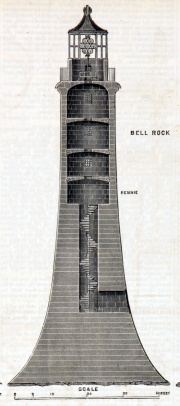John Rennie (1761-1821)

John Rennie (1761-1821)
1761 June 7th. Born at Phantassie, near East Linton, East Lothian, the youngest of the nine children of James Rennie (d. 1766), a farmer and owner of a brewery, and his wife, Jean, née Rennie (1720–1783).
1775–7 Attended Dunbar high school
A tinkerer and model builder even as a child, he first worked as a millwright with noted mechanical engineer Andrew Meikle (inventor of the threshing machine). Rennie then attended the University of Edinburgh (1780-1783) and began work as an engineer, employed by Boulton and Watt for five years at mill building, and working under James Watt from 1783. He was a pioneer in substituting cast iron for wood in structures, at Boulton and Watts' Albion Mills in London, 1789, but this was burnt down by arson in 1791.
In 1791, he moved to London and set up his own engineering business, having by then begun to expand into civil engineering. His early projects included the Lancaster Canal (started 1792), the Chelmer and Blackwater Navigation (1793), the Crinan Canal (1794) and the Kennet and Avon Canal (also started 1794) along with a drainage scheme for draining the Norfolk Fens (1802-1810).
Over the next few years he became a famous bridge-builder, combining stone with new cast-iron techniques to create previously unheard-of low, wide elliptical arches, at Leeds Bridge, and in London at Waterloo Bridge (1811-1817), with its nine equal arches and perfectly flat roadway (thought to be influenced by Thomas Harrison's design of Skerton Bridge over the River Lune in Lancaster), and Southwark Bridge (1815-1819).
Rennie was also responsible for designing and building docks at Hull, Liverpool, Greenock and Leith and improving the harbours and dockyards at Portsmouth, Chatham and Devonport. Rennie's last project was London Bridge, still under construction when he died in 1821 but completed by his son, also John Rennie. His other son was George Rennie.
1821 October 4th. Died.[1]
1821 October 16th. He was buried in St Paul's Cathedral. Full details. Mourners include his four sons and many other known names.[2]
1821 November. Obituary.[3]
See Also
Sources of Information
[1] Wikipedia

